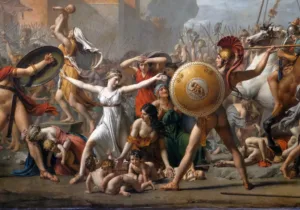As the Thirty Years’ War waged in Europe, another sectarian conflict was being fought hundreds of miles to the east. In 1632 the armies of Safavid Persia marched against the Ottoman Empire. Following a series of revolts in Mesopotamia against the Ottomans, the Safavids sought to reverse territorial losses they had suffered during their previous war, and their armies invaded modern Iraq and converged on Baghdad.
The city was an important prize due to its strategic location, history as the Abbasid Caliphs’ capital, and symbolism within Islam. The armies laying siege were composed of Turkmen and Kurdish tribal forces, Caucasus slave soldiers called ghulams, in addition to Persian and Arab conscripts. Ottoman forces were unable to relieve the city, and it fell on January 14, 1624. Safavid troops poured into the city and systematically slaughtered the Sunni population.
Abbas I, the Safavid Shah, approved of this massacre because he wished to see Baghdad made a loyal Shiite city. According to Shiite theology, Shah Abbas governed the state of Iran on the behalf of the Hidden Imam. Sunnis understood his opponent, Sultan Murad IV, to be the Caliph and therefore leader of the Islamic community. Slaughter of the Sunnis in Baghdad reflected a greater conflict within the Islamic world.
In theory all Muslims, regardless of ethnicity, are part of a single metaphysical community called the Uhmma. However, traditional Islamic theology also understood this not only to be a universal religious community of believers, but also a political community. Sunnis swore allegiance and submitted to the Caliph, and similarly Shiite clerics recognized the Shah as God’s vice-regent on earth. Both men could possibly claim to be head of the Islamic World since they both claimed to belong to the same indivisible Islamic community. In the eyes of Shah Abbas, the slaughter in Baghdad was a massacre of political opponents who did not acknowledge him as the rightful steward of the Islamic community.
The Ottoman-Safavid War ended in 1639 with the Treaty of Zuhab after the Ottomans drove the Safavid forces from Mesopotamia. This took place nine years before the Thirty Years’ War ended with the Treaty of Westphalia. While the Treaty of Westphalia led to the death of Christendom as a political unit and the rise of European nation-states, the Treaty of Zuhab was not nearly as revolutionary. Zuhad’s main effect was to mark territorial divisions of both empires, creating borders which last to this day. However, both empires’ primary political, social, and religious underpinnings remained unaffected. Islamic religious ideology used to understand how the state and society should be governed remained mostly unchanged until the 1800s and 1900s. Only after both empires failed to embrace substantive reform and fend off foreign threats did these political orders collapse, ending the systems which had governed the Middle East for centuries.
This civilizational upheaval is at the heart of the modern Middle East’s biggest problems. While many social and political elites embraced other ideologies—such as Marxism, nationalism, and constitutionalism—for others, the end of the Ottoman and Persian empires did not discredit political Islam. Even after the Islamic empires’ collapse and the West’s imposition of nation-states upon the Middle East, the Islamic ideology survived. Some preached that the old dynasties had failed because the leaders had grown decadent and corrupt, and their teachings inspired Islamic revivalist movements such as the Muslim Brotherhood.
If the past few decades have made one thing clear, it’s that non-Islamic ideologies that entered the Middle East following World War I are currently faltering. While Arabs feel a deep cultural affinity for each other, Arab nationalism is dead. President Nasser in Egypt failed to sustain a pan-Arab state and failed to reverse Arab losses to the Israelis, largely discrediting the ideology. In Iraq, the pan-Arab ideology of the Baath party fell to American power. In Syria, the Assad regime is currently crushing any illusions of Arab unity under the treads of its tanks.
The Iranian Revolution in 1979 brought the Middle East’s confessional history back with a vengeance when widespread riots overthrew Mohammed Reza Shah. The revolution would come to be defined by Ayatollah Khomeini, who envisioned a state where Shiite clerics would serve as ideological guardians. The Islamic Republic of Iran harkens back to the transnational identity of the old Islamic empires. Its defining feature is the regime’s particular brand of ideological Shi’ism, a revolutionary ideology that the government seeks to export to other countries and enshrine as orthodox religious doctrine among Shiites globally. Iran’s Islamic Revolutionary Guard Corps is active in the Syrian Civil War, directing Shiite Afghans, Lebanese Hezbollah, and Iraqi Shiite militias. As the war wages on, the depopulated lands are being resettled with Shiite Arabs from Lebanon and Iraq in an attempt to change Syria’s religious demographics.
Meanwhile, Sunni forces are also moving through the region. When the Islamic State (ISIS) rolled into Iraq, it claimed it was abolishing the Sykes-Picot Agreement and reinstituting the caliphate. Four years later ISIS may be breathing its last breath, but it successfully overturned Iraqi and Syrian politics, if not abolished the Sykes-Picot order altogether. But ISIS’ global ideological calls, which inspired recruits from around the world, may be its most lasting effect in decades to come.
The end of ISIS, however, offers little to the territorial integrity, national survival, or even the independence of Iraq and Syria. Iran may fill this vacuum with a “Shia Crescent” stretching from Iran to the Mediterranean, creating new religious fault lines between Iran and neighboring Sunni countries. It remains to be seen if another state will take up the mantle of Sunni leadership.
Despite their claims, these Islamic ideologies are not pure forms of past religious theology, but are rather revivalist ideologies that have evolved in response to other ideologies. Still, the fact remains that the Islamic Republic of Iran has created a theocratic Shiite order which performs much of the same functions, religiously speaking, that the Shah traditionally fulfilled. The Islamic State attempted to revive the spirit of the caliphates which preceded it.
Officially, Iraq and Syria still exist, but they are split between vying factions operating under the spheres of influence of other regional powers, themselves divided along religious lines. While the newer ideologies that have shaped the Middle East are not dead, traditional religious conceptions of community, state, and God are on the rise.
—
Justin Roy holds a Masters in History from the University of San Diego, with an emphasis on Middle Eastern history.
Photo Credit: Nouri Mosque in Mosul, Iraq, after Retaken from Islamic State. By Tasnim News, via Wikimedia Commons.






